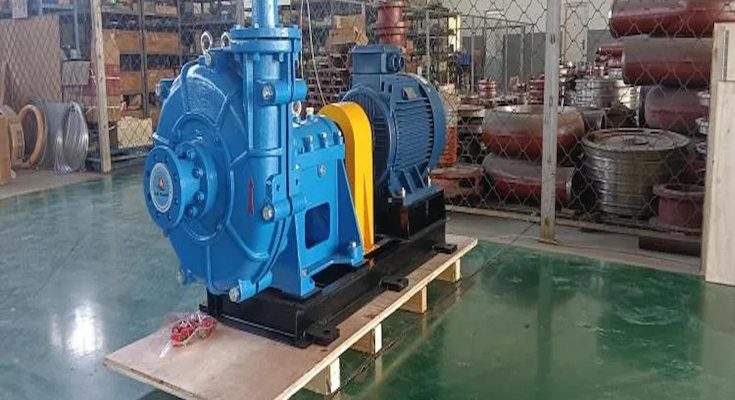Mining is tough work. It’s a process that involves moving abrasive, dense, and sometimes corrosive mixtures of solids and liquids. This combination is known as a slurry, and handling it correctly is critical to maintaining efficient and safe operations. Whether it’s transporting tailings or mineral-rich mud, the job demands a special kind of pump.
That’s where the high head slurry pump comes in. In this article, we’ll explore why this equipment is vital, how it works, and why it’s essential for effective slurry transfer in mining.
What Is Slurry?
Before diving into pump details, let’s first understand what a slurry is.
Slurry is a thick, muddy mixture made of water and fine solid particles. It forms naturally in mining during extraction, grinding, and mineral processing. Depending on the site, slurry can vary in thickness, temperature, and chemical content. That’s why handling it requires a specialised system that can tolerate wear and maintain performance over long distances.
The Challenges of Slurry Handling
Slurry is no ordinary liquid. Moving it is far more demanding than pumping water or oil. Here’s why:
- It’s heavy and dense.
- It contains abrasive solids that wear down pump components.
- It’s often corrosive due to the presence of minerals and chemicals.
- It settles fast when the flow slows down.
These factors put intense pressure on pumps. Without the right type of equipment, you risk breakdowns, costly delays, and even safety hazards.
What Makes a Slurry Pump Different?
Standard pumps are not built to handle abrasive materials. Slurry pumps are. They are specially designed with features that allow them to:
- Resist abrasion and corrosion.
- Pump solid-laden liquids at high pressure.
- Operate efficiently even with thick mixtures.
Slurry pumps come in many types. But for long distances and steep lifts, you need one with extra power and resilience. That’s when a high-head slurry pump becomes essential.
What Is a High Head Slurry Pump?
A high-head slurry pump is a heavy-duty pump designed for slurry transfer over long distances or to high elevations. The term “head” refers to the height a pump can push slurry. A “high head” refers to the ability to lift the slurry further vertically, which is crucial in deep mining or when transferring materials uphill or through long pipelines.
These pumps are made with robust components like:
- Reinforced casings
- Hardened impellers
- Thicker liners
- Heavy-duty bearings
They’re built to last and keep moving slurry in even the harshest environments.
When Do You Need a High Head Slurry Pump?
Not all operations require this level of strength. However, certain scenarios make high head pumps indispensable. Here are key examples:
1. Long-Distance Slurry Transfer
If your mine has a long pipeline running from the pit to the processing plant, you need enough pressure to keep the slurry moving. A pressure drop can cause the solids to settle, resulting in blockages and requiring expensive cleanouts. High-head pumps prevent this by maintaining a strong flow over long stretches.
2. Steep Elevation Changes
Mines often involve changes in height, either pumping up from underground shafts or across elevated terrain. A high-head slurry pump provides the power to lift slurry to the required height without losing efficiency.
3. Thicker or Denser Slurries
The more solids in your slurry, the harder it is to move. High-head pumps can handle higher concentrations without clogging or breaking down. This is especially useful in tailings disposal or concentrate pipelines.
Installing and Maintaining Your High Head Slurry Pump
Even the best pump won’t perform well without proper installation and care.
Installation Tips
- Ensure a stable foundation to handle vibration.
- Use correct alignment to avoid wear.
- Allow space for inspection and maintenance.
Maintenance Guidelines
- Inspect wear parts regularly.
- Monitor for vibration or unusual noise.
- Keep bearings and seals lubricated.
- Flush the system after shutdowns to prevent blockages.
Preventive maintenance extends the pump’s lifespan and maintains consistent slurry transfer performance.
Common Mistakes to Avoid
Using the wrong pump or neglecting upkeep can cost you. Watch out for these common errors:
- Undersizing the pump for distance or head.
- Overloading with too dense a slurry.
- Letting solids settle during shutdowns.
- Skipping scheduled maintenance.
Avoiding these mistakes ensures smoother operations and less downtime.
Industry Applications Beyond Mining
Though mining is the most common field, high head slurry pumps are used in other sectors too:
- Dredging: Moving sand and silt from riverbeds or harbours.
- Power generation: Handling ash slurry in coal plants.
- Steel production: Transporting slag or mill scale.
- Chemical processing: Pumping corrosive slurries with high solids.
Wherever heavy-duty slurry transfer is needed, these pumps deliver reliable results.
Final Thoughts
A high-head slurry pump isn’t just another piece of equipment—it’s the backbone of any mining operation that relies on consistent, long-distance slurry transfer. When you invest in the right pump, you get more than just machinery. You get uptime, efficiency, and peace of mind.
The mining industry is built on productivity. And nothing supports that better than a reliable, heavy-duty slurry pump built to go the distance. If your slurry has far to go or steep terrain to climb, don’t settle. Go for the pump that’s designed for the job.



